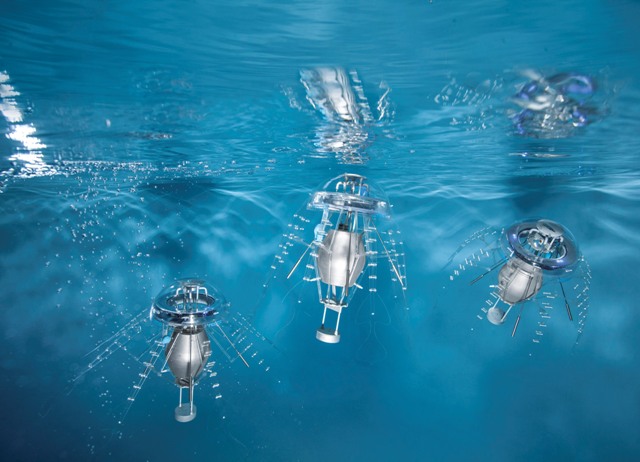Jun 15 2015
Festo‘s bionic projects illustrate how networking and real-time communication can work in process automation. At ACHEMA 2015, the 31st international trade fair for process industry taking place from the 15th to the 19th of June in Frankfurt am Main, Germany, Festo will present two of those projects at once. In hall 8, stand C72 Festo shows the autonomous, swimming jellyfish AquaJellies 2.0; in hall 11, stand G44 the floating eMotionSpheres. Both projects use principles from nature and demonstrate how these can be applied in automation technology.
 AquaJellies 2.0 – artificial, autonomous jellyfish equipped with an electric drive unit and an intelligent, adaptive mechanism which enables a coordinated, collective behaviour. (Photo: Festo)
AquaJellies 2.0 – artificial, autonomous jellyfish equipped with an electric drive unit and an intelligent, adaptive mechanism which enables a coordinated, collective behaviour. (Photo: Festo)
Festo’s AquaJellies are artificial, autonomous jellyfishes with electric drive and an intelligent, adaptive mechanical system. The AquaJellies were developed as part of the Bionic Learning Network. The autonomous jellyfishes, which are equipped with communicative capabilities, embody innovative developments in the areas of system capabilities, energy efficiency, communication and lightweight construction.
These technological showpieces consist of a translucent hemisphere and eight tentacles which provide forward thrust. A watertight, laser sintered pressure hull is located at the middle of the AquaJelly. This encloses a central electric drive, two rechargeable lithium-ion-polymer batteries of the same size as smartphone batteries, a charging controller and servomotors for the swash plate.
Real-time monitoring on a smartphone
An app can be used to individually record and track the current condition of each AquaJelly. Thanks to real-time diagnostics, it is possible to make a parameter query about the current battery status, the temperature, the current power consumption and the depth of the jellyfish in the water. A movement profile also shows in which direction the jellyfish in question is swimming.
Avoiding collisions
Each artificial jellyfish decides autonomously which action it will take on the basis of its own status. “The integrated communication and sensor technology plus the real-time diagnostics enable a coordinated, collective behaviour even in a limited space,” explains Dr. Elias Maria Knubben, Head of Corporate Bionic Projects. “Festo is using these bionic technology bearers to visualise potential and ideas of how efficient systems in the field of water technology may look in the future. Process monitoring and condition monitoring are important topics in all equipment used in the process industry and hence also in the water technology sector.”
Transferring this principle to the field of automation makes it possible for many decentralized intelligent systems to work together and to execute large tasks with small systems which act together in a targeted fashion.
At ACHEMA 2015, Festo will present the AquaJellies 2.0 in hall 8, stand C72. Presentations will be held at 10 a.m., 12 p.m. 2 p.m. and 4 p.m.
eMotionSpheres – Collision-free motion of autonomous systems in an area
Real-time communication between multiple systems is also a central aspect of the second bionic project Festo will be showing at ACHEMA: eMotionSpheres. These are eight white spheres filled with helium and driven by small propellers. These flying objects, which Festo developed in 2014, demonstrate how several objects can be coordinated without colliding in a three-dimensional space thanks to multifaceted networking.
Ten cameras installed in the room record the spheres via their active infrared markers (infrared LEDs) and pass on the position data to a central master computer. The actions calculated are sent back to the objects, where they are locally implemented. Thanks to additionally stored behaviour patterns, the spheres can equally move autonomously through the space, however. There are no collisions even in chaotic situations, as they move out of each other’s way. The spheres can also be controlled individually by people and, because of their process reliability, consistent lightweight design and flexible propellers they are safe and easy to operate.
The knowledge gained from the work on the BionicOpter in 2013 went into the design of the adaptive propellers. The developers pursued the wing principle on the artificial dragonfly and transferred it to the unique drives used by the spheres. The drives are adaptive, supplying the same efficient thrust in a forwards and reverse direction. Each of the eight spheres has a diameter of 95 cm and is filled with helium. As the spheres stop at their charging stations regularly and autonomously, they can be used as flying objects for several days without a person having to intervene.
Insights for the future of automation
With the eMotionSpheres installation and the indoor GPS (Global Positioning System) derived from it, Festo addresses aspects of the automation of the future, such as the safe and intuitive interaction between man and machine or the autonomous and adaptable behaviour of technical systems, which permit controlled interventions by people at any time and hence create new prospects for the workspace of the future. In the field of logistics, the system could be put to use as a way of monitoring the function of small robots or vehicles.
At ACHEMA 2015, Festo shows the eMotionSpheres as part of hourly presentations (11 a.m., 3 p.m. and 5 p.m.). In hall 11, stand G44, the flying spheres will fascinate visitors.
Further information can be found at: www.festo.com/bionic